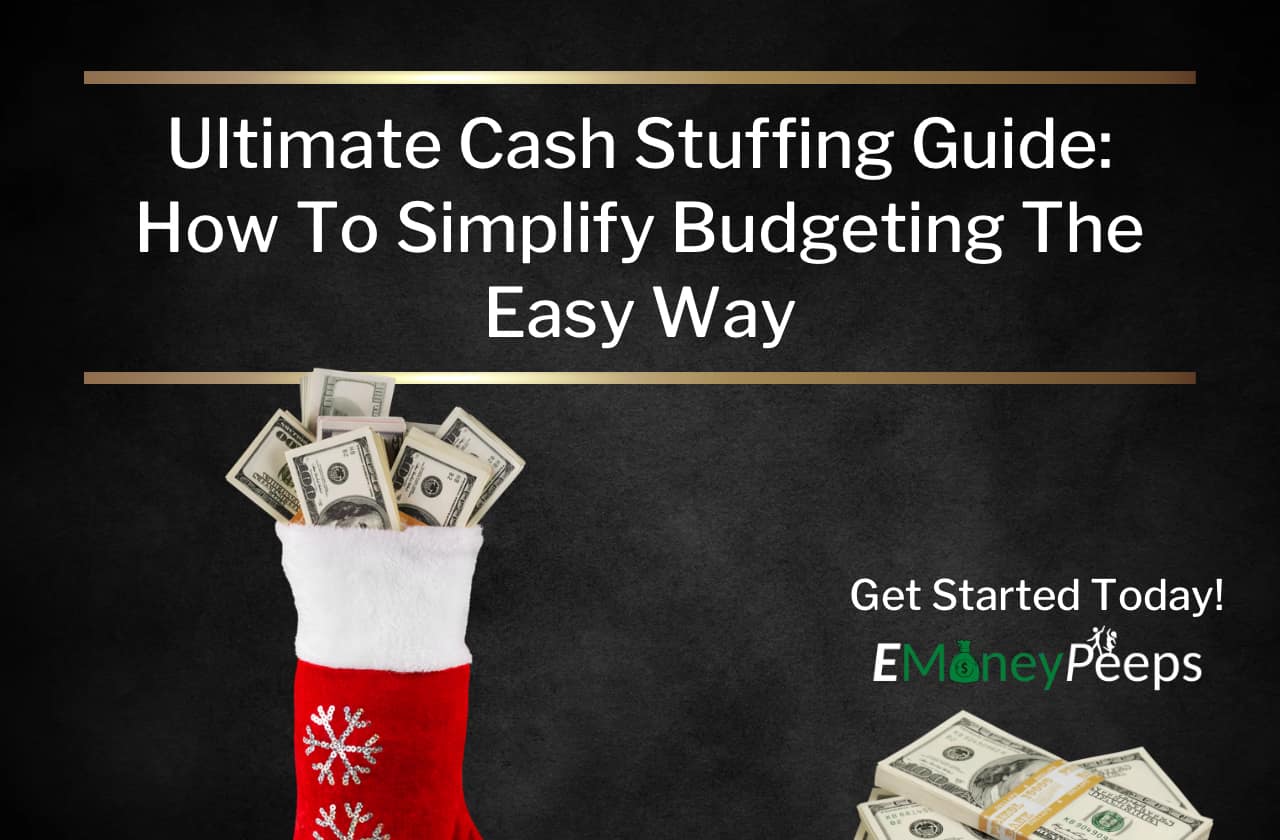Ultimate Cash Stuffing Guide: How To Simplify Budgeting The Easy Way

Managing money can feel overwhelming, but a simple budgeting method called cash stuffing is helping people take control of their finances.
Whether you’re looking to pay off debt, build savings, avoid overspending, or save money to buy new furniture, this guide will explain everything you need to know about cash stuffing and how to get started..
What Is Cash Stuffing?
Cash stuffing is a budgeting technique where you allocate cash, or in my wife’s case checks into labeled envelopes for specific expenses and savings goals.
It’s a modern spin on the “envelope system” popularized by financial experts.
By using this budgeting system, you can visually track your spending and stick to your budget more effectively.
It is truly a great way to master your finances and understand where all your money is being spent.
Cash stuffing is also referred to as the cash envelope budget system, or even just the envelope budget system.
And in my wife’s case, it is the check stuffing method, I’ll explain her version as well.

How Does Cash Stuffing Work?
Cash stuffing works by dividing your income into envelopes that represent different spending categories, such as groceries, rent, utilities, future purchases, or entertainment.
Each envelope is filled with the cash you plan to spend on that category during a specific period, such as a week or a month.
Once the cash in an envelope is gone, you’re done spending in that category until the next budgeting cycle.
This method encourages you to be more intentional with your money and helps prevent overspending since you can’t spend what you don’t have.
My Wife’s Method is similar, except she writes herself checks every month, subtracts them from her checkbook balance and put the checks in envelopes.
And my wife only does it for future expenses or purchases she wants to make, so that when she goes to pay for something it is always in cash per-say, meaning – no loan or credit card needed.
She does this with gift cards and cash as well. Anytime she receives cash or gift cards for a gift or any other reason, she puts them in envelopes for specific uses.
These are her kind of cash (check) stuffing envelope categories:
- Eyeglass fund
- Furniture fund
- Quit Smoking Fund – She quit many years ago now, but still has an envelope for this, and puts money in it every month.
- Medical Fund
- Heating Season Fund – we have a boiler that heats are home in the winter, and it uses fuel oil. We never have to worry about money to heat our home.
- Christmas Fund
- Rainy Day Fund
- New Car Fund, and anything else she wants to purchase with cash.
Once she purchases new furniture as an example, she starts a new envelope for the next most important thing she wants to purchase.
For her, she lives by her check book register for all budgeting, but does not include in her envelopes monthly bill expenses.
She makes sure all of the biggest expenses for her are always well taken care of. So she does not need to be as tight for budgeting with other expenses that come in monthly, because there are no surprise expenses she can not afford to pay in cash.
I just wanted to point out her method as well, because it works extremely well for her, and she saves A LOT OF MONEY this way, and can be another alternative method for you to consider.
My wife has been budgeting this way for over 20 years, she was trendy before the cash stuffing envelope budget system was ever a thing.
Note: And no my wife does not pay for everything..lol. We are both very financially successful, and do not need each others money. I use a completely different method, that I will explain in an upcoming article.
How To Use Leverage In Your Life To Get Rich

How to Start Cash Stuffing: Steps to Getting Started
Starting cash stuffing is easy with a little planning. Follow these steps to begin:
Step 1: Assess Your Income and Expenses
Start by calculating your total income and listing your monthly expenses. Include fixed bills (like rent and utilities) and variable expenses (like groceries and entertainment).
This gives you a clear picture of your financial situation.
Step 2: Create Spending Categories
Decide on the categories for your envelopes. Common examples include rent, groceries, gas, savings, and entertainment.
Tailor these categories to fit your lifestyle and financial goals.
Step 3: Allocate Your Cash
Based on your budget, decide how much cash to put into each envelope. For example, if your monthly grocery budget is $400, set aside $100 per week in the groceries envelope.
Step 4: Withdraw Your Cash
Head to the bank and withdraw the total amount of cash you need for the budgeting period. Break it into smaller denominations if necessary to make stuffing envelopes easier.
Step 5: Stuff Your Envelopes
Distribute the cash into your envelopes according to your budget. Keep the envelopes organized and in a safe place, such as a locked box, safe, or wallet designed for cash stuffing.
Cash Stuffing Envelope Categories List
You should have an envelope for every bill, expense, or savings goal. Common categories include:
- Rent or Mortgage
- Utilities (Electricity, Gas, Water)
- Groceries
- Transportation (Gas, Public Transit)
- Entertainment
- Dining Out
- Emergency Fund
- Vacation Fund
- Debt Repayment
- Clothing
Tailor your categories to suit your financial situation and priorities.
How To Get Out Of Debt Fast In 8 Steps
Long-Term Plan
While cash stuffing is great for managing day-to-day expenses, it’s also a powerful tool for long-term financial planning.
Create envelopes for future goals like retirement savings, a down payment on a house, or your child’s education.
Over time, these small, consistent contributions can lead to significant savings.

Why Should People Try Cash Stuffing?
Cash stuffing forces you to confront your spending habits and provides a tangible way to manage your money.
If you’ve struggled with staying within a budget or avoiding credit card debt, this hands-on approach can help you take control of your finances.
Additionally, cash stuffing builds discipline and awareness about where your money goes, making it easier to prioritize your financial goals.
Pros and Cons
The Pros to Cash Stuffing
- Visual accountability: Seeing your cash helps you understand your limits.
- Debt prevention: Avoiding credit cards reduces the risk of accumulating debt.
- Customizable: You can create envelope categories that suit your needs.
- Savings boost: Setting aside money for specific goals makes saving easier.
The Cons to Cash Stuffing
- Inconvenience: Carrying cash isn’t always practical, especially in a digital world.
- Security risks: Keeping cash at home can be risky without proper safeguards.
- Lack of credit card rewards: You miss out on cashback or points offered by cards.
Main Benefits You Will Experience By Cash Stuffing
- Improved Financial Discipline: You’re less likely to overspend when you have a clear, tangible budget.
- Enhanced Savings Habits: Regularly funding envelopes for goals helps build wealth over time.
- Reduced Financial Stress: Knowing exactly where your money is going provides peace of mind.
- Better Money Management: Cash stuffing simplifies budgeting, making it easier to stay on track.

Wrapping Up
Cash stuffing is an effective and beginner-friendly budgeting method that can transform the way you manage money.
By using this budgeting system, you’ll gain control over your spending, build savings, and work toward financial freedom—all while keeping it simple and stress-free.
Get started today and see how cash stuffing can change your life. Cash stuffing makes very clear the reality of personal finance and how to balance your budget.
We really hope this article Ultimate Cash Stuffing Guide: What It Is & How to Get Started has been extremely helpful to you.
If you have any questions, don’t hesitate to post them in the comments section below or just say hello.
Sincerely,
Your Friends And Partners
Richard And John Weberg

Copyright Notice: If this content is reproduced in full on any other website other than EmoneyPeeps.com, it is without our permission, and is copyright infringement. We own all rights to this article. Any attempts to infringe the website content will result in strict legal actions. You are free to link to any article on our website, but not copy our content.

